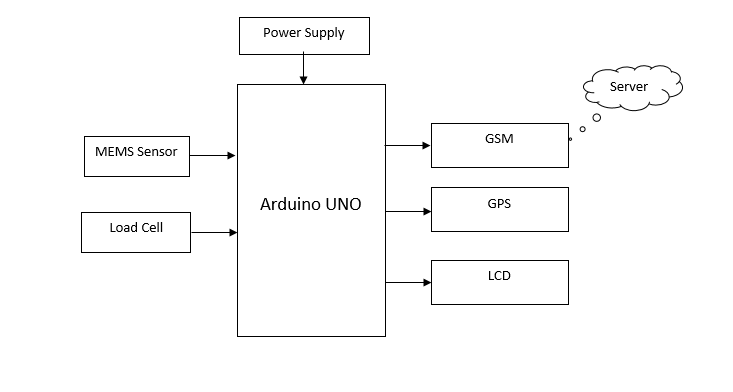A system of IoT Devices to prevent under-loading overloading of Railway wagons.
Objective
The main objective of this project is to implement a system of IoT devices that prevents the under-loading and overloading of railway wagons, thereby ensuring safe and efficient cargo transportation and preventing potential accidents or damage to the railway infrastructure.
Abstract
Efficient and safe railway transportation is a cornerstone of modern logistics, and the loading of railway wagons is a crucial aspect of this process. This project introduces a comprehensive System of IoT Devices designed to prevent both under-loading and overloading of railway wagons. The system incorporates an Arduino UNO microcontroller, load cells for load detection, MEMS sensors to act as virtual doors for theft detection, GSM modules for sending SMS alerts and cloud data upload, GPS for location tracking and information sharing, and an LCD display for data visualization.
The IoT system operates by continuously monitoring the load within railway wagons. Load cells ensure that both under-loading and overloading are detected, optimizing the loading process. The MEMS sensors act as virtual doors, detecting any unauthorized entry or potential theft. GSM modules enable SMS alerts and data upload to the cloud, ensuring that relevant personnel are immediately informed of any anomalies. The GPS component tracks the location of railway wagons and shares this information through SMS, providing an additional layer of security and oversight. Data is visualized on an LCD display, allowing for immediate insights and decisions.
This innovative System of IoT Devices offers a comprehensive solution to address the challenges of under-loading and overloading in railway transportation. It enhances efficiency, security, and safety in the logistics industry, contributing to reliable and cost-effective railway operations. Further research and testing are necessary to validate its performance in various railway settings and refine its features for practical implementation.
Keywords: Arduino UNO, Load detection, GSM, GPS, Server, Thingspeak
NOTE: Without the concern of our team, please don't submit to the college. This Abstract varies based on student requirements.
Block Diagram

Specifications
Hardware Components:
- Arduino UNO
- Load Cell
- MEMS Sensor
- GSM
- GPS
- LCD
- Power supply
- Adaptor
Software Components:
- Arduino IDE
- Embedded C
Learning Outcomes
- Arduino pin diagram and architecture
- How to install Arduino IDE software
- Setting up and installation procedure for Arduino
- Introduction to Arduino IDE
- Basic coding in Arduino IDE
- Working of LCD
- Interface LCD with Arduino
- Working of power supply
- About Project Development Life Cycle:
- Planning and Requirement Gathering (software’s, Tools, Hardware components, etc.,)
- Schematic preparation
- Code development and debugging
- Hardware development and debugging
- Development of the Project and Output testing
- Practical exposure to:
- Hardware and software tools.
- Solution providing for real time problems.
- Working with team/ individual.
- Work on Creative ideas.
- Project development Skills
- Problem analyzing skills
- Problem solving skills
- Creativity and imaginary skills
- Programming skills
- Deployment
- Testing skills
- Debugging skills
- Project presentation skills


 Paper Publishing
Paper Publishing
